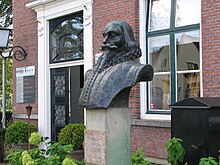Jan Adriaanszoon Leeghwater
Jan Adriaanszoon Leeghwater (* 1575 in De Rijp , Netherlands as Jan Adriaanszoon ; † 1650 in Amsterdam ) was a Dutch engineer, mill and wind pump designer and architect .
Live and act
His pioneering work was the drainage of the large lake of Beemster (ndl. Beemstermeer) at the beginning of the 17th century. He is considered to be the inventor of the rotating mill cap (see Dutch mill ). Leeghwater came from a poor farming family and was a trained carpenter. In many cases he had taught himself his knowledge in the fields of mechanics, hydraulic engineering and engineering as well as languages as an autodidact . In his hometown De Rijp he was a member of the liberal Mennonite community of the Waterlanders.
The drainage of the Beemster lake was one of the largest projects ever completed in the area, adding 6,880 hectares to the agricultural area of the Netherlands. Land is of particular importance to the relatively small nation of the Dutch, whose land was largely extracted from the low marshes of Europe's west coast. For centuries the areas wrested from nature, the so-called polders , had to be defended against the sea, against lakes or swamps, which tried again and again to assert themselves. Since the Netherlands is one of the most intensely built-up countries in the world, new areas are constantly needed - nothing has changed since Leeghwater.
The ambitious and expensive project came about when a group of directors from the Dutch East India Company were looking for investment opportunities for the wealth they had acquired in the Far East. The project was advertised and several candidates submitted bids until Leeghwater was finally awarded the contract on April 10, 1608. The contract stipulated that the ring dike should be completed on November 1, 1609. 26 water mills were set up at certain intervals to pump out the water for the 38-kilometer circular dike. The work was completed just a short time after the scheduled deadline, but a month later a violent winter storm broke the dike, half destroying it. The work was immediately resumed and within three years the agricultural use of the polder could be started. Soon the income from the fertile soil covered the construction costs.
After successfully draining the Beemster lake, Leeghwater became a very busy man. He took care of the drainage of more than 30 lakes and swamps: Heerhugowaard (1625), Purmer (1622), Schermer (1635), Starnmeer and De Wormer (1626). He set about draining the swamps near Bordeaux (1628) and Metz (1630). In Schleswig-Holstein he was able to close the Bottschlotter Tief near Dagebüll (1633).
He also took part in the conquest of 's-Hertogenbosch fortress in 1629, which was considered impregnable because of the surrounding marshy terrain. Leeghwater diverted two rivers and drained the swamp with pumps driven by windmills so that the town could be taken within four months. Leeghwater was a multi-faceted person. He designed and built furniture, drew sketches and made sculptures in wood, stone, ivory and metal. He also built bridges and church towers, including those of the Westkerk and Zuiderkerk in Amsterdam , both of which he fitted out with bells. Still, Leeghwater failed to achieve his most ambitious plan. He wanted to drain the constantly growing Haarlemer See , for which, according to his calculations, he would have needed no fewer than 160 water pumps driven by windmills. This project, which even his successors could not manage, could only be realized with the help of modern engineering and the steam pumping stations of the 19th century. Previously, Leeghwater had revived the traditional Dutch polder drainage system, which is why he deserves a place among the best engineers in history.
Individual evidence
- ^ Piet Visser: Traces of Menno . Kümpers Verlag, 1996, ISBN 3-930435-20-9 , pp. 137 .
Web links
| personal data | |
|---|---|
| SURNAME | Leeghwater, Jan Adriaanszoon |
| BRIEF DESCRIPTION | engineer |
| DATE OF BIRTH | 1575 |
| PLACE OF BIRTH | De Rijp , Netherlands |
| DATE OF DEATH | 1650 |
| Place of death | Amsterdam |

